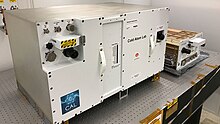Cold Atom Laboratory

The Cold Atom Laboratory (CAL) is an experimental instrument on board the
Timeline
The CAL was developed at JPL in Pasadena, California.[3] It was originally scheduled for launch to the International Space Station (ISS) in June 2017.[4] It was then delayed until a scheduled launch on a SpaceX CRS-12 rocket in August 2017.[5] It was finally launched on May 21, 2018.[2] The initial mission had a duration of 12 months with up to five years of extended operation.[4]
In January 2020 it underwent hardware upgrades, which were carried out over an eight-day period by astronauts Christina Koch and Jessica Meir under the supervision of ground controllers.[1] The upgrade included an atom interferometer which can be used to study the equivalence principle.[6]
In July 2021, another upgrade by astronaut Megan McArthur gave CAL the ability to work with ultracold potassium atoms in addition to rubidium atoms.[7]

Purpose
The instrument creates extremely cold conditions in the
Results
The results of the experiments from 2019 were reported in 2020, demonstrating successful operation of the laboratory. This enables improved research of BECs and quantum mechanics, since physics are scaled to macroscopic scales in BECs. The lab supports long-term investigations of few-body physics, and supports the development of techniques for atom-wave interferometry and atom lasers.[9][10]
See also
- Bose–Einstein correlations
- Bose–Einstein condensation: a network theory approach
- Bose–Einstein condensation of excitons
- Macroscopic quantum phenomena
- Macroscopic quantum self-trapping
- Slow light
- Timeline of low-temperature technology
References
- ^ a b "The Space Station's Coolest Experiment Gets Astronaut-Assisted Upgrade". NASA/JPL. Retrieved 2020-09-13.
- ^ a b "NASA is creating a super cold lab in space to study quantum physics/". QUARTZ. 2018-05-24. Retrieved 2018-05-24.
- ^ Elizabeth, Landau (2016-03-18). "Cold Atom Laboratory Doing Cool Research". NASA. Retrieved 2020-11-19.
- ^ a b c d e f "Cold Atom Laboratory". coldatomlab.jpl.nasa.gov. Retrieved 2019-08-29.
- ^ "NASA to launch Cold Atom Lab in space". 8 March 2017.
- ^ Green, Jim; Elliot, Ethan (2021-08-06). "Season 5, Episode 13: Freaky Physics on the Space Station". NASA Gravity Assist. Retrieved 2022-01-25.
- ^ "Upgrading the Space Station's Cold Atom Lab With Mixed Reality". coldatomlab.jpl.nasa.gov. 2021-10-26. Retrieved 2022-01-23.
- ^ "Cold Atom Laboratory Creates Atomic Dance". NASA News. 26 September 2014. Archived from the original on 2021-07-08. Retrieved 2015-05-21.
- ^ "Quantum 'fifth state of matter' observed in space for first time". phys.org. Retrieved 4 July 2020.
- S2CID 219568565. Retrieved 4 July 2020.
External links
 Media related to Cold Atom Laboratory at Wikimedia Commons
Media related to Cold Atom Laboratory at Wikimedia Commons- Cold Atom Laboratory – Project web site at JPL
